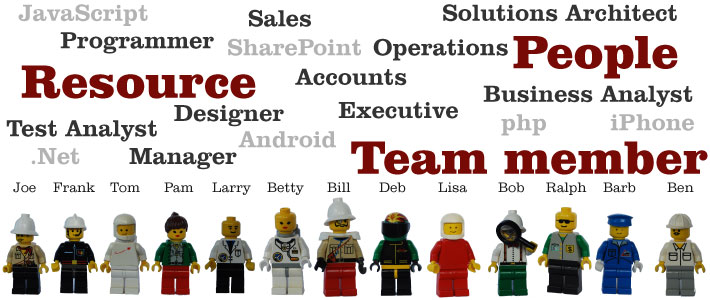Referring to people as resources: Three reasons why we do it and what to do about it

I recently came across this critique aimed at those who use the word “resource” to refer to people. The post inferred that those who use such terminology are careless, less enlightened, number-crunchers, and lacking in courtesy.
The blogger above is not alone in his critique. Others have taken a similar position that:
- people are not productivity factors;
- managers use the term in order to disassociate themselves from decisions that alter people’s lives and affect families;
- calling employees a resource is like using the term on your children;
- it is a poisonous word that widens the gap between managers and drones; and
- people are not interchangeable or mechanic.
The last example makes it very clear that those who use the term “resources” are simply “doing it wrong”.
I respect the positions above, although they take a pretty strong position against a word. Is the use of the word appropriate? Is it inevitable? Or is the use of the word not as important as the culture and intent behind it?
Three reasons why it happens

I will come out and say it: I am guilty as charged. I will even admit to using the more callous phrase “bodies”, as in “We will need more [insert technology] bodies on that project in a few weeks”.
My purpose here is not to apologise, justify, excuse or defend the practice. Indeed, for most of my career you could place me in the same camp as the critics in the links above.
Six years ago I started on a path towards an MBA, but paused after a few courses because I felt like the degree was more about the numbers and not enough about the people. So I switched to a Masters of Applied Social Science (Management) with a specialist psychology college. I held an idealistic perspective that if organisations took care of their people, the rest would sort itself out. It wasn’t until I was almost finished that I realised my degree was part of the discipline of Human Resource Management.
As I move through my fifteenth year of doing some form of management or leadership in manufacturing, professional services and not-for-profit organisations, I see three factors as to why the word “resource” creeps into my vernacular:
- We are all resources to The Client
A client once affectionately referred to my studio as “a large professional family”. A few years later faced with opportunities for rapid growth, that same client said we were a sausage factory and that more sausages were needed. I now see both perspectives.Yes, clients want the innovation that comes from people who are passionate, engaged, and feel connected. This comes when people are motivated through autonomy, mastery and purpose. A sense of “family” results when people feel connected to those around them and when they see their DNA in the organisation.Clients also do not want to hear that their million dollar promotion is delayed due to so-and-so being sick or that additional projects must wait due to not having enough “resources”.A few ways to address this dichotomy are to: 1) maintain your internal culture, 2) acknowledge the boundary points between internal and client cultures, and 3) set up processes to ensure the alignment between the two is managed. This is a balancing act between serving the internal team and supporting client scale-ability. Energy spent on being offended at being considered a “resource” is counter-productive and better spent on getting it right in those three areas. - We are taught to use The Language
Open up Microsoft Project and you will see that the right-hand column is called “resources”. Recruitment companies, project management methodologies and academic institutions all use the term “resources” to refer to people in organisations.You can understand why managers scratch their heads in confusion when they are criticised for using the term resources. It seems silly that I spent half a decade getting a degree in a discipline I can’t refer to by name. - A response to The Complexity
Reducing things down to abstract models helps make sense of the world. The more complex the situation, the more valuable it is to reduce things to a model. When I am project managing a team of five, I know each person by name. When I am responsible for the flow of 30 projects for 15 clients through six teams of three to five team members across five technologies and disciplines, I admit to thinking of people as resource types. The greater the pressure, the more this is the case.
The three faces of the “resource”

All that said, I like to think I am open to change and correction. As part of my ponderings here I asked the opinion of people (resources? team members? employees?) in my company. The response I received varied for and against.
A couple said they appreciated I was aware of the concern. Most, however, just looked at me like they were not sure what I was going on about. Some attributed a “resource” as someone who contributes, who adds value. Many viewed themselves as flexible resources, flitting from one discipline to another based on need. This was seen as part of the appeal of the environment in which we work, an environment created from how people are perceived in the company.
I continue to use the term, but staff are more than just numbers. I see people as having three aspects to who they are. First, they are part of the organisation, sharing in and contributing to the vision and direction. Second, they are individuals, each with their own goals and aspirations. Finally, they hold a position or role as part of a team within the organisation.
The model above is reflected in the performance review process we have in the studio.
First, we discuss their perception of the company vision, whether they feel aligned with where the company is going, whether they see that vision as appropriate in the current market, and what they and the company can do to better realise that vision. Second, we consider together what they see as the purpose of their position, where they see themselves contributing to their team, and what goals they could set to further their career. Finally, we have a conversation about their personal goals, ensure they have work-life balance, and determine if there are any ways the company can help them in areas outside of the workplace.
Staff will be considered as resources so long as we have commercial pressures, the language of business, and the complexity of the work. It takes more than a word change to create a culture that celebrates the individual in their role of helping achieve the company vision. As a manager, I will be judged not on my use of a word, but on the extent that I support my company in achieving its objectives in parallel with assisting individuals realise their potential.
I welcome your input. Do you consider team members as resources? Do you mind being called a resource? Do you take offence when you hear others use the term? Or after reading this post do you just want to play with Legos? Feel free to Like and let me know below!

I dislike the term resources when organisational culture treats one like a sausage in a sausage factory. It is particularly offensive when one’s manager etc. doesn’t really know who you are, what you’re interested in, or where you’re going.
I understand the use of the term resources. I once worked in human resources. However, I always made a point to know the people I worked with. They were people with families, dreams and aspirations. When used in this context, the term is appropriate.
I suppose I could have just said “ditto” to your post and agreed that it’s appropriateness is highly contextual.
I have been leading people over the last decades and always hurt my ears the usage of Resources to treat people. On doing so, leaders are building up a massive gap missing great opportunity to obtain the best of their….resources!? We can only take the best from people if we have a personal approach.
When you are leading 30 projects, 15 clients etc, its your responsibility as leader to set the structure adequately, with a meaningful span of control. Therefore, no excuses are accepted to have the right amount of PEOPLE reporting to you such a way you can still understand them beyond the professional boundaries.
That said, do I consider team members as resources? NO.
Do I mind being called a resource? YES.
Do I take offence when you hear others use the term? YES.
Or after reading this post do you just want to play with Legos? Well, I wish I could make money playing with Legos at home, but the reality is that my passion is to improve people’s performance in the workplace as well as in their personal lives.
I enjoyed reading your post though and I am sure that despite the few comments so far, it helps us to think about our roles and responsibilities as leaders, employees and more importantly, as human beings.